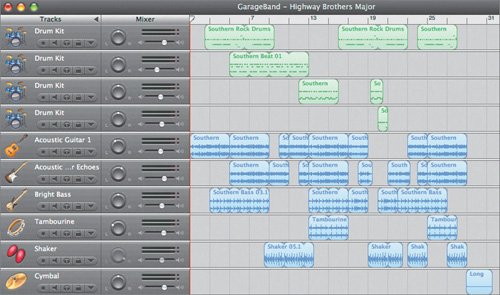| Musical instruments such as the piano or guitar play a variety of scale types including major, minor, and both. You don't have to be a music major to understand and recognize the difference. In fact, the important thing for GarageBand is just working with parts that sound good together. Music played in the minor scale has a serious feel that is often used to evoke tension or drama. The song you've been working with"Highway Brothers"used a lead instrument in a minor scale type. Music played in the major scale has a happier, more positive feel and is often used for more upbeat, feel-good songs. Let's open a different version of the Highway Brothers song. It has the same rhythm tracks (drums), but all of the guitar and bass parts were replaced with loops from the major scale type. Note Major guitar parts usually sound good together, and minor guitar parts also sound good together. On the other hand, you generally don't want to mix major and minor guitar parts, at least not at the same time.
1. | Open the project 7-7 Highway Brothers Major from the Lesson_07 folder, and save it as Highway Brothers Major to your My GarageBand Projects folder.
 | | | 2. | Play the first part of the song to hear the difference of using major scale type loops.
It's a totally different feeling and a much happier song. This version feels like the Highway Brothers are really excited about their lives on the road traveling around and playing different venues every night. The original minor version was a bit more depressing and seemed much more serious.
I also noticed that the new major version of the song feels a little rushed, and it could benefit from a slightly slower tempo. Did you notice that, too? If so, your ear training is also leading you toward song producing as well.
| 3. | Lower the project's tempo to 100. Then play the first part of the song again to hear it with the revised tempo.
That's better. This would be good opening music for a documentary about the brothers heading out on their lifetime highway tour. The minor version would be better for the end of the documentary after they've been on the road for 20 years together.
So, how do you sort loops by scale type? Simple. Just choose the scale type in the Loop Browser using the Scale pop-up menu.
| 4. | Press Cmd-L to open the Loop Browser, and select the Guitars keyword button.
 The Scale pop-up menu at the bottom of the browser shows the current scale type. There are five different choices in the Scale pop-up: Any, Minor, Major, Neither, and Good For Both. These different categories are self-explanatory. The Scale pop-up menu at the bottom of the browser shows the current scale type. There are five different choices in the Scale pop-up: Any, Minor, Major, Neither, and Good For Both. These different categories are self-explanatory.
The default setting is Any scale, which you have been using on all of the songs you've created in this book.
There are more than 70 guitar loops included with GarageBand.
| | | 5. | Change the Scale pop-up to Minor and notice how many guitar loops match the minor scale.
There are 22 minor guitar loops included with GarageBand.
Note The specific number of minor guitar loops may vary on your computer if you have added more loops to the original installation. | 6. | Preview some of the minor scale guitar loops in the results list to hear the serious, dramatic sound of minor scale loops.
| 7. | Change the Scale pop-up to Major.
There are almost twice as many major guitar loops as minor ones because major loops are more common.
| 8. | Preview some of the major scale guitar loops in the results list to hear the happier, more feel-good sound of major scale loops.
| 9. | Change the Scale pop-up back to Any. Then hide the Loop Browser.
|
The next time you want to build a song using Apple Loops, you can adjust the scale type to fit the song. |

 The Scale pop-up menu at the bottom of the browser shows the current scale type. There are five different choices in the Scale pop-up: Any, Minor, Major, Neither, and Good For Both. These different categories are self-explanatory.
The Scale pop-up menu at the bottom of the browser shows the current scale type. There are five different choices in the Scale pop-up: Any, Minor, Major, Neither, and Good For Both. These different categories are self-explanatory.